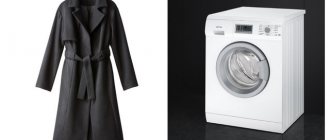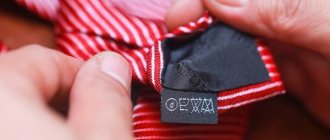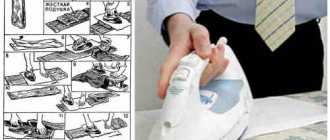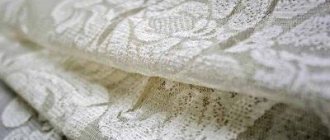Polyester is a very popular synthetic fabric that can come in different thicknesses and textures. It can be similar to silk, wool, cotton or linen fabric. Polyester fabric is used to make various items of clothing: skirts, trousers, T-shirts, blouses, coats, raincoats, sweaters, shirts. Polyester is used to make curtains and furniture upholstery. This material is inexpensive and has high wear resistance. In order not to spoil things, you should follow a number of rules when ironing polyester fabric.
Polyester fabrics have a number of advantages:
- do not shed;
- do not wear out;
- serve for a long time;
- wrinkles badly;
- not damaged by moths;
- resistant to dirt.
Knowing how to iron polyester, you can enjoy your favorite things for a long time.
How to iron out a wrinkled polyester jacket at home
Outerwear is often made from polyester, since this fiber allows you to achieve different textures of the fabric. It is more difficult to iron outerwear: it is bulkier, heavier and has many hard-to-reach places for ironing. Dried outerwear after washing looks very wrinkled. How to iron a polyester jacket without ruining the item?
There are several rules on how to properly iron polyester if the fabric is wrinkled and looks untidy.
If you wash and dry polyester clothes correctly, ironing them will take a minimum of time, or you won’t have to iron them at all.
Important! Before washing polyester items, you should read the care instructions on the label sewn into the garment.
How to properly wash polyester:
- The water temperature when washing items made from synthetic fibers should not be higher than 400C. At higher temperatures, the color of the fabric may fade.
- The washing machine should be set to a delicate cycle and spin at low speed.
- Before washing, clothes should be sorted by color. Dark clothes cannot be washed together with light or colored ones.
- To avoid a yellow coating when ironing the fabric, it is better to give preference to liquid powders when washing.
- Bleaching agents should not be used on polyester.
- In the washing machine, you can wash only 1 down jacket at a time: when wet, feather jackets become very bulky and heavy.
- Jackets with padding polyester should be washed inside out or in a special protective bag.
- Places with heavy soiling (cuffs, collars, top edge of pockets) before the main wash are best washed with a brush.
- After removing the washed down jacket from the drum of the washing machine, you need to blot it with a towel, shake it, holding it alternately by the bottom and top of the product. This manipulation will allow the filler to distribute inside and straighten the fabric.
- Hang the jacket or raincoat over your shoulders and let it dry.
- While drying, the down jacket should be shaken from time to time: the fabric is smoothed out and the down is distributed evenly inside.
Important! If the jacket does not have insulation, you can stuff the sleeves with crumpled paper when drying. You may not need to iron a jacket that is already dry.
A polyester jacket can be ironed at minimum iron power through a damp towel or gauze folded in 4 layers. The product is ironed from the wrong side. First the collar, then the back, front and lastly the sleeves. A jacket with insulation, if necessary, is ironed on the outside. After the product is ironed, you need to hang it on hangers, fasten all the buttons, and let it “rest” for at least an hour, and then hang it in the closet. Just like a jacket, you can iron a polyester raincoat.
A piece of fabric from which the clothing is made is sewn into the seam of a factory jacket, along with a label containing care instructions. On this piece you can test how the fabric behaves when washed and ironed.
Features and nuances
- It is better not to iron a polyester jacket or other outerwear
. If there are no strong folds or creases on it, then it is better to leave it without ironing - such clothes will iron out on their own. But if you still need to iron it, you need to start with the lining. You can't press too hard. Be sure to use a dampened cotton towel or gauze. - A dress or skirt with folds or pleats must be carefully ironed with the tip of the iron. Fasten the folds with small pins, connect the front and side seams, and then iron the product.
- As for polyester curtains, in most cases there is no need to iron them - just hang them on the curtain rod after spinning. At the same time, ironing gives them a flawless look. To do this, just set the “Silk” mode, turn the curtains inside out and iron them through a damp cloth.
Most often, polyester is used in combination with other materials. Thus, for summer and holiday clothing a mixture of polyester and lycra is used, for winter clothing - polyester with wool. A mixture of nylon and polyester is used to produce work jackets, and a mixture of cotton and polyester is used for work overalls. In this regard, it is necessary to study how your specific material from which the item is made reacts to ironing.
Can I iron it out with an iron?
If polyester clothing is very wrinkled, you need to pay attention to the instruction label sewn into the seam to understand how to properly iron polyester. The label indicates whether the product can be ironed and at what temperature.
Synthetic fabrics are ironed only at low temperatures.
Fabrics made from 100% polyester should be ironed at the minimum heating setting (on an iron this setting may be labeled “Silk”), at a temperature of 60-80 0C. Fabrics containing less than 84% polyester can be ironed at a temperature not exceeding 110 0C. For polyester products, choosing the correct ironing temperature is very important. After all, the fabric can deteriorate from high temperatures. Before ironing the entire garment, you need to conduct a test on an inconspicuous part of the garment (inner cuff, facing).
Shirts, blouses, skirts, blouses, and trousers made of synthetic fabric are ironed through gauze or fabric. When ironing polyester items, you should always start from the wrong side. If necessary, then iron the outer side.
For trousers, first smooth out the burlap of the pockets, then fold the trouser legs along the arrows and carefully iron them, trying not to spoil the arrows.
Can polyester be ironed?
Polyester is a component of many fabrics. And it gives them a number of advantages. One of the advantages is low creasing. If the item was properly stored in the closet, then it practically does not need ironing. However, it happens that if stored or dried incorrectly, creases form, which can only be removed by ironing.
Therefore, the answer to the question is it possible to iron polyester - yes, it is possible. But some rules must be followed. Artificial fabric, although durable, is quite easily susceptible to high temperatures. And when exposed to heat, this fabric has the ability to remember its shape. Which is beneficial when you need to create folds on a skirt or shirt, but completely inconvenient if the item is ironed incorrectly. It is very difficult to remove creases that form when heated.
It is impossible to get rid of ironing completely. But you can make this process easier if you properly prepare the fabric. In some cases, proper preparation helps you iron clothes containing polyester quickly and without problems.
Polyester was first studied in 1946 in the USA. And mass distribution began in the 60s. XX century. This material appeared in our country in 1949 and quickly gained popularity and widespread use.
Do I need to dampen the fabric before ironing?
If a product made of polyester fabric is very wrinkled, it is better to moisten it in water before ironing. You can do this in the following way:
- pour cold water into the basin, no higher than 40 degrees;
- carefully lower the clothes into it;
- remove and gently squeeze without twisting;
- let the water drain and the product dry;
- iron the product from the inside out on a low heating setting of the iron, starting from the back;
- hang the ironed clothes on a hanger and let cool.
If you don’t have time for such a procedure, you can wet the item with a spray bottle or spray water from the iron, and then iron the item.
We recommend:
What to do if no steam comes out of your handheld steamer
Important! Before hanging clothes in the closet, you need to let it completely dry and cool.
How to iron synthetic fabric with a steamer
For polyester clothing, it is better to choose steaming rather than ironing. On an iron with a vertical steam function or a steamer, set the heat level to minimum. Hang the product on a hanger and straighten it out. From a distance of 2-3 centimeters, treat the entire surface of the jacket with steam. Polyester does not tolerate high temperatures. If you bring the iron too close to or touch the fabric, it may cause holes or melt marks.
The steaming procedure must first start from the back, move to the shelf, then the sleeves and collar. Folds in clothing need to be steamed especially carefully and thoroughly. On pleated skirts, secure the pleats with pins before steaming.
Important! The higher the temperature of the iron, the farther its sole should be from the product.
This steam method of processing the product will not only give the fabric smoothness, but also get rid of the unpleasant odor and minimize the risk of spoiling the material, which is not resistant to high temperatures.
Is it possible to do without electrical appliances?
One of the features of fabrics made from polyester fibers is that they wrinkle poorly. If the product is carefully washed and dried properly, most likely ironing will not be required at all. But with prolonged or careless storage, creases may form on these fabrics that require smoothing. It will not be easy to iron a heavily wrinkled item with an iron; it is better to resort to another method. This method of removing wrinkles is also suitable for those synthetic fabrics that cannot be ironed.
A few tips on how to iron out synthetic fabric without an iron or steamer:
- after washing, the clothes should be straightened by holding the top of the item and shaken;
- carefully hang the clothes on hangers or on the dryer in a straightened form, fasten all fasteners;
- leave in this position until completely dry.
If you do not follow the conditions for washing and drying clothes indicated above, the dried items will turn out to be very wrinkled. How to unravel polyester in this case? There is the following method for this. The bath or basin is filled with hot water. Clothes are hung on hangers and all fasteners are fastened. Leave to “steam” indoors for 20–30 minutes, it may take longer if the folds have not straightened out during this time. During this time, the fabric will be saturated with moisture and folds and creases will be smoothed out. Steamed clothes should be moved to a dry room to dry. Do not hang clothes on or very close to heating appliances.
Strong creases should be straightened out during the drying process; the product can be shaken from time to time so that strong creases are straightened out.
Advantages of polyester fibers
What is good about polyester:
- easy to wash and dry quickly;
- resistance to stains;
- no deformation;
- good air conductivity;
- hardly wrinkles when worn;
- does not fade after washing and does not fade under ultraviolet light.
The material will remain unchanged for several seasons, the colors will be just as bright.
Conclusion
In order for things made of polyester to always look neat and last a long time, you must adhere to several rules:
- wash on delicate cycle;
- wash clothes, sorting them by color;
- dry after straightening the fabric, avoiding direct sunlight;
- iron at minimum temperatures;
- When ironing, use a backing made of gauze or cotton fabric.
Caring for polyester fabrics is not at all difficult, and your favorite items will delight you with their attractive appearance for many years.
Rate this post
Folk smoothing method
This ironing method was used by grandmothers; it is also ideal for those who do not have an iron with temperature control or who are afraid of ruining their favorite item. This age-old method of smoothing things out is very effective, but quite troublesome.
You can also iron polyester items with regular hot water. The item should be placed on hangers, after fastening all the buttons, in the bathroom, then turn on the hot water and close the door tightly. Just half an hour, and sometimes 15 minutes, is enough for all the wrinkles on the item to straighten out under the influence of steam. Then you should move your favorite clothes from the bathroom to a regular room and let them dry completely.
Instead of the bathroom, you can iron the item in the kitchen. After tightly closing the doors and windows, place a large container of water on the stove. The water will boil and the steam will smooth out even the most capricious wrinkles. After this, the item is also moved to a regular room, and before putting it on or putting it in the closet, it is thoroughly dried, without removing it from its hanger.
If you are afraid of ruining your outerwear, you can go to a dry cleaner. There, with the help of professionals, your favorite raincoat or jacket will take on an impeccable appearance, restore its brightness and delight you for many more seasons.
Polyester is widely used not only for the production of everyday outerwear and underwear, but also for the production of bed linen, furniture upholstery, for sewing bedspreads, curtains, etc. At the same time, it is used both as the main material and can be added as an admixture to other fabrics to improve their properties.
Other advantages of polyester products include the fact that they are resistant to moths, repel water, do not fade in the sun, do not fade and are resistant to regular washing, do not lose their shape for a long time due to the coarse fibers in the structure, are resistant to dirt, and do not wrinkle when worn. Unlike natural fabrics, they allow air to pass through well. Of course, such products are not the best choice for winter or summer, but for the autumn or spring the choice of such things is optimal.











